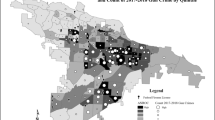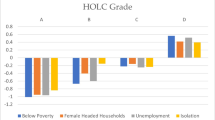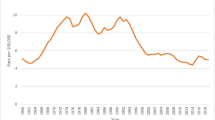Abstract
A spatially disadvantaged census tract is one that is surrounded by disadvantaged tracts. More spatially disadvantaged neighborhoods may experience more violence, independent of their own level of disadvantage, and majority Black middle-class neighborhoods are more likely to be spatially disadvantaged than majority white neighborhoods. The purpose of this paper is to study how much of the racial difference in gun homicide rates between majority Black and majority white middle-class neighborhoods can be explained by differences in spatial disadvantage. To study this, comparable majority Black and majority white tracts were matched to understand how gun homicide rates differ in neighborhoods with similar levels of disadvantage. Further matching on spatial disadvantage reduced the disparity in gun homicides between majority Black and majority white middle-class neighborhoods, suggesting that spatial disadvantage accounts for some but not all of the disparity.

Similar content being viewed by others

References
Cheon C, Lin Y, Harding D, Wang W, Small D. Neighborhood racial composition and gun homicides. JAMA Netw Open. 2020;3(11):e2027591. https://doi.org/10.1001/jamanetworkopen.2020.27591.
Sharkey P. Spatial Segmentation and the Black middle class. Am J Sociol. 2014;119(4):903–54. https://doi.org/10.1086/674561.
Peterson RD. Divergent social worlds: neighborhood crime and the racial-spatial divide. New York, NY: Russell Sage Foundation; 2010.
Sampson RJ. Great American city: Chicago and the enduring neighborhood effect. Chicago, IL: University of Chicago Press; 2012.
Hemenway D, Nelson E. The scope of the problem: gun violence in the USA. Curr Trauma Rep. 2020;6:29–35. https://doi.org/10.1007/s40719-020-00182-x.
Gunderson L. The financial costs of gun violence. Ann Intern Med. 1999;131:483–4. https://doi.org/10.7326/0003-4819-131-6-199909210-00102.
QuickStats: Age-adjusted rates of firearm-related homicide, by race, Hispanic origin, and sex — National Vital Statistics System, United States, 2019. MMWR Morb Mortal Wkly Rep 2021;70:1491. https://doi.org/10.15585/mmwr.mm7042a6external icon.
Sampson RJ, et al. Neighborhoods and violent crime: a multilevel study of collective efficacy. Science. 1997;277(5328):918–24. https://doi.org/10.1126/science.277.5328.918.
Morenoff JD, Sampson RJ, Raudenbush SW. Neighborhood inequality, collective efficacy, and the spatial dynamics of urban violence. Criminology. 2001;39:517–58. https://doi.org/10.1111/j.1745-9125.2001.tb00932.x.
Tyler TR. Policing in Black and White: ethnic group differences in trust and confidence in the police. Police Q. 2005;8(3):322–42. https://doi.org/10.1177/1098611104271105.
Macdonald J, Stokes RJ. Race, social capital, and trust in the police. Urban Affairs Review. 2006;41(3):358–75. https://doi.org/10.1177/1078087405281707.
Lerman AE, Weaver VM. Arresting citizenship: the democratic consequences of American crime control. The University of Chicago Press, 2014.
Bell MC. “Police reform and the dismantling of legal estrangement.” The Yale Law Journal, https://www.yalelawjournal.org/essay/police-reform-and-the-dismantling-of-legal-estrangement.
Ratcliffe JH. A Temporal constraint theory to explain opportunity-based spatial offending patterns. J Res Crime Delinq. 2006;43(3):261–91. https://doi.org/10.1177/0022427806286566.
Pizarro JM, Corsaro N, Violet Yu S-S. Journey to crime and victimization: an application of routine activities theory and environmental criminology to homicide. Victims & offenders. 2007;2(4):375–94. https://doi.org/10.1080/15564880701568520.
Pattillo ME, Lareau A. Black picket fences: privilege and peril among the Black middle class. The University of Chicago Press, 2013.
Brokamp C, Beck AF, Goyal NK, Ryan P, Greenberg JM, Hall ES. Material community deprivation and hospital utilization during the first year of life: an urban population-based cohort study. Ann Epidemiol. 2019;30:37–43. https://doi.org/10.1016/j.annepidem.2018.11.008.
Hansen BB, Fredrickson M, Fredrickson MM, Rcpp L, Rcpp I. Package ‘optmatch’; 2022. Accessed September 10, 2022. https://cran.r-project.org/web/packages/optmatch/optmatch.pdf.
Rosenbaum PR, Silber JH.. Using the exterior match to compare two entwined matched control groups. The American Statistician, 2013; 67(2), 67–75. http://www.jstor.org/stable/24591435
Rosenbaum PR. A characterization of optimal designs for observational studies. J R Stat Soc. 1991;53(3):597–610. https://doi.org/10.1111/j.2517-6161.1991.tb01848.x.
Rosenbaum PR. Design of observational studies. 2nd ed. Cham, Switzerland: Springer Nature; 2020.
Silber JH, Rosenbaum PR, McHugh MD, Ludwig JM, Smith HL, Niknam BA, et al. Comparison of the value of nursing work environments in hospitals across different levels of patient risk. JAMA Surg. 2016;151(6):527.
Funding
We are grateful for support for this project from the Wharton Dean’s Research Fund.
Author information
Authors and Affiliations
Corresponding author
Additional information
Publisher's Note
Springer Nature remains neutral with regard to jurisdictional claims in published maps and institutional affiliations.
Supplementary Information
Below is the link to the electronic supplementary material.
Rights and permissions
Springer Nature or its licensor holds exclusive rights to this article under a publishing agreement with the author(s) or other rightsholder(s); author self-archiving of the accepted manuscript version of this article is solely governed by the terms of such publishing agreement and applicable law.
About this article
Cite this article
Salmon, T., Lin, Y., Harding, D.J. et al. Spatial Disadvantage and Racial Disparities in Gun Homicides. J. Racial and Ethnic Health Disparities 10, 2490–2495 (2023). https://doi.org/10.1007/s40615-022-01429-w
Received:
Revised:
Accepted:
Published:
Issue Date:
DOI: https://doi.org/10.1007/s40615-022-01429-w



